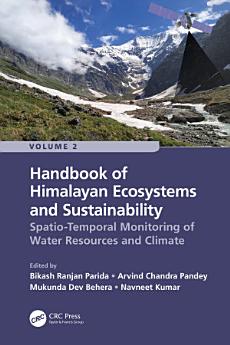Handbook of Himalayan Ecosystems and Sustainability, Volume 2: Spatio-Temporal Monitoring of Water Resources and Climate
eBook 정보
Key Features
- This book is unique as it focuses on the utility of satellite data for monitoring snow cover variability, snowmelt runoff, glacier lakes, avalanche susceptibility and flood modeling.
- Explain how Remote Sensing techniques are useful for mapping and managing the morphology and ecology of the Himalayan River.
- Addresses how geospatial technologies are valuable for understanding climate change impact on hydrological extremes, the potential impact of land use/land cover change (LULC) on hydrology and water resources management.
- It highlights the impact of LULC changes on land surface temperature, groundwater, and air pollution in urban areas.
- Includes contributions from global professionals working in the HKH region.
Readership
The Handbook serves as a valuable reference for students, researchers, scientists, Hydrologists, hydro-ecologists, meteorologists, geologists, decision makers and all others who wish to advance their knowledge on monitoring and managing water resources and urban ecosystem using remote sensing in the HKH region considering climate change.
저자 정보
Bikash Ranjan Parida is an assistant professor at Central University of Jharkhand (CUJ), India since September 2016. He received his M.Sc. in Geoinformatics (2006) from the University of Twente and his PhD from the University of Hamburg/ Max Planck Institute for Meteorology (2011). Prior to joining CUJ, he was employed by various premium institutes involved in Earth and Environmental studies He has contributed to several national research projects such as Science and Engineering Research Board (SERB) under the Department of Science and Technology (DST), Start-Up Research Grant by UGC, NISAR project by SAC, Ahmedabad, ISRO. He has more than 40 research publications in peer-reviewed journals.
A.C. Pandey is a professor in the Department of Geoinformatics at Central University of Jharkhand (CUJ), India. He is the former Head of the Department of Geoinformatics (2013-2020) and the former Dean of the School of Natural Resource Management (2013-2016) at CUJ. He has been the CUJ Coordinator for ISRO and EDUSAT program since 2013. From 2004-2013 he was an associate professor of Remote Sensing in Birla Institute of Technology. He received his Ph.D. degree in Geology from Department of Geology at the University of Delhi in 2001. He has published more than 70 articles and two edited books. He is the recipient of NASA-SERVIR Fellowship in 2013 to work on Himalayan glaciers in Zanskar Valley, J&K.
Mukunda Dev Behera has made outstanding contributions to the fields of forest remote sensing and ecological climatology. His research innovations have fundamentally transformed the study of phytogeography, with attention to ecological functioning of three ecosystem components, plant diversity-water-energy. Dr. Behera has been a Guest Editor for six special issues and has served in three editorial boards of Springer’s journals: Biodiversity and Conservation, Environmental Monitoring and Assessment, and Tropical Ecology. With over 20-year research and teaching experience, he has published over 100 articles.
Navneet Kumar is a senior researcher at the Center for Development Research (ZEF), University of Bonn in Germany. He received his PhD in Engineering from the University of Bonn. His main research fields are water and natural resources management and Geoinformatics. Dr. Kumar has contributed to several projects in Algeria, Ethiopia, India, Mali, Niger and Uzbekistan. These projects include research on the impact assessment of climate change and land use change. He has presented his work in several international conferences and has published with several journals.




